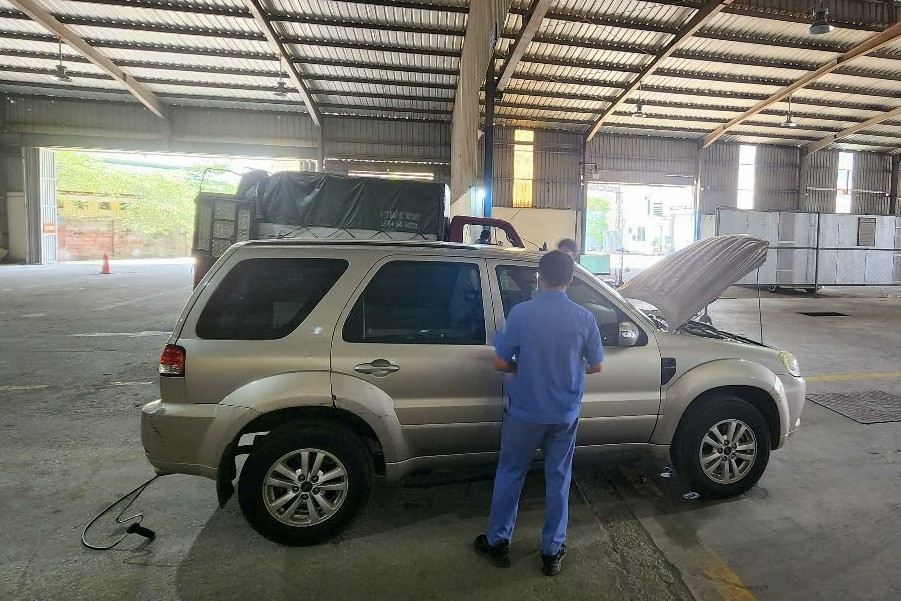For the first time, Vietnam is drafting a National Technical Regulation on emissions from in-use automobiles, expected to be issued later this year.
The newly added Level 5 emission limit tightens restrictions but remains more lenient than the European Euro 5 standards.

According to sources from VietNamNet, the draft regulation and a Prime Ministerial decision outlining the implementation roadmap are being reviewed by relevant ministries.
Level 5 added to in-use car emission limits
The draft regulation sets maximum limits for three key pollutants: carbon monoxide (CO), hydrocarbons (HC) for spark-ignition engines (gasoline vehicles), and smoke density (N) for compression-ignition engines (diesel vehicles).
For standard gasoline vehicles with four-stroke engines:
Level 1: CO ≤ 4.5%, HC ≤ 1200 ppm
Level 2: CO ≤ 3.5%, HC ≤ 800 ppm
Level 3: CO ≤ 3%, HC ≤ 600 ppm
Level 4: CO 0.3-0.5%, HC 200-300 ppm
Level 5: CO 0.2-0.3%, HC 100-150 ppm
Two-stroke gasoline engines, mainly vintage cars from East Germany, are capped at HC 7800 ppm for all five levels.
For diesel vehicles (measured in HSU - Hartridge Smoke Units):
Level 1: ≤ 72%
Level 2: ≤ 60%
Level 3: ≤ 50%
Level 4: ≤ 45%
Level 5: ≤ 35%
These figures are based on TCVN 6438:2018 and expand it by including the new Level 5 threshold.
This is the first time in over 30 years of automotive industry development that Vietnam is formulating a national regulation on emissions for in-use vehicles, which will have higher legal force than the current standards.
This is a key step in implementing Decision 876 (2022) by the Prime Minister on green energy transition in transport, aiming to phase out internal combustion engines.
Currently, the Prime Minister’s draft decision on the emission roadmap is open for public consultation. The Ministry of Agriculture and Environment is collecting input before submitting the regulation to the government.
As previously reported by VietNamNet, stricter emissions limits will apply sooner to vehicles registered in Hanoi and Ho Chi Minh City, where PM2.5 pollution levels frequently exceed WHO recommendations.
The nationwide roadmap includes:
Pre-1999 vehicles: Level 1
1999–2016 vehicles: Level 2
Post-2017 vehicles: Level 3 from 2026
Post-2022 vehicles: Level 4 from 2026, Level 5 from 2028
For Hanoi and HCMC-registered vehicles:
Post-2017: Level 4 from 2026
Post-2022: Level 5 from 2027
Vietnam’s standards more lenient than Euro norms
Deputy Director General of the Environment Agency Le Hoai Nam emphasized that these Vietnamese levels differ from Euro standards (set by the EU for new vehicles). For example, Euro testing includes real-world driving measurements, while Vietnam uses idle testing and measures pollutant concentration by volume.
Currently, new vehicles in Vietnam meet Euro 4 (from 2017) or Euro 5 (from 2022) standards under Decision 49/2011 and Decision 19/2024. However, in-use vehicles are only subject to Level 2 under TCVN 6438:2018 - well below the regional average. Thailand requires Euro 4, while Singapore enforces Euro 5 or 6. Although Levels 3 and 4 exist in the standard, they are not yet applied to vehicles on the road.
Even though both systems have five levels, Vietnam’s version is significantly more relaxed, especially in testing methods and emission thresholds. Euro standards, for example, also factor in brake and tire particles and will introduce Euro 7 in 2027, covering all vehicle types including electric and hybrid models.
According to a Vietnamese vehicle inspection expert, even new vehicles built to Euro 4 or 5 specs may fail emission checks if not regularly maintained - achieving only Level 1 or 2 in real conditions.
During the initial implementation of Decision 16/2019, nearly 26,000 vehicles failed their first emissions check and had to be repaired. Level 2 emission limits have applied since 2020–2021 to cars manufactured from 1999 onward.
Mr. Le Hoai Nam concluded that the gap between emissions standards for new and in-use vehicles is a regulatory inconsistency.
Effective control requires coordination across sectors - from manufacturing and fuel imports to infrastructure - under the Ministry of Industry and Trade and the Ministry of Construction.
Pham Huyen